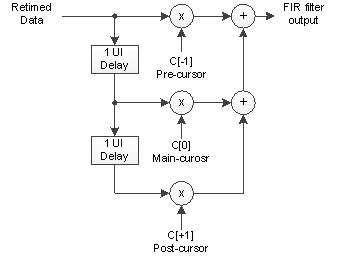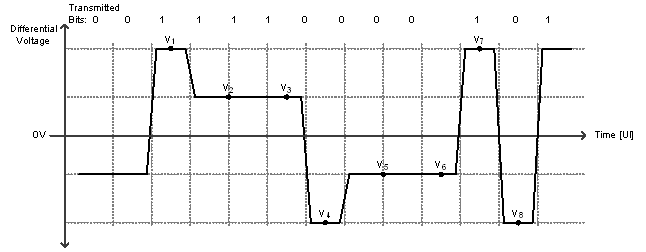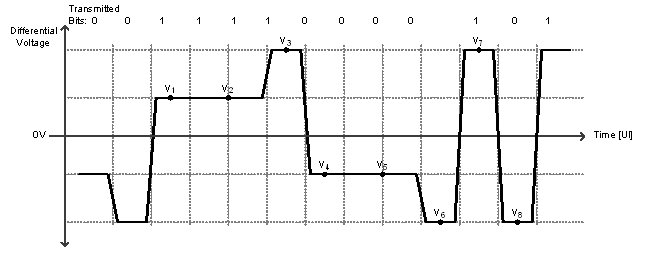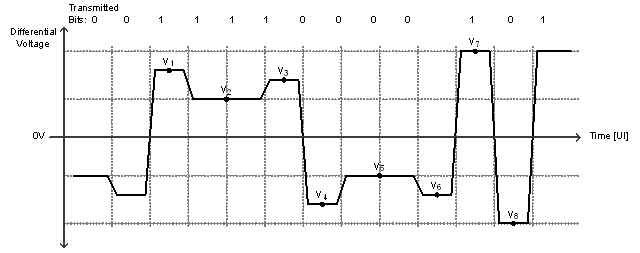SNLS456D March 2016 – October 2019 DS250DF410
PRODUCTION DATA.
- 1 Features
- 2 Applications
- 3 Description
- 4 Revision History
- 5 Description (continued)
- 6 Pin Configuration and Functions
-
7 Specifications
- 7.1 Absolute Maximum Ratings
- 7.2 ESD Ratings
- 7.3 Recommended Operating Conditions
- 7.4 Thermal Information
- 7.5 Electrical Characteristics
- 7.6 Timing Requirements, Retimer Jitter Specifications
- 7.7 Timing Requirements, Retimer Specifications
- 7.8 Timing Requirements, Recommended Calibration Clock Specifications
- 7.9 Recommended SMBus Switching Characteristics (Slave Mode)
- 7.10 Recommended SMBus Switching Characteristics (Master Mode)
- 7.11 Recommended JTAG Switching Characteristics
- 7.12 Typical Characteristics
-
8 Detailed Description
- 8.1 Overview
- 8.2 Functional Block Diagram
- 8.3
Feature Description
- 8.3.1 Device Data Path Operation
- 8.3.2 Signal Detect
- 8.3.3 Continuous Time Linear Equalizer (CTLE)
- 8.3.4 Variable Gain Amplifier (VGA)
- 8.3.5 Cross-Point Switch
- 8.3.6 Decision Feedback Equalizer (DFE)
- 8.3.7 Clock and Data Recovery (CDR)
- 8.3.8 Calibration Clock
- 8.3.9 Differential Driver with FIR Filter
- 8.3.10 Debug Features
- 8.3.11 Interrupt Signals
- 8.3.12 JTAG Boundary Scan
- 8.4 Device Functional Modes
- 8.5 Programming
- 8.6 Register Maps
- 9 Application and Implementation
- 10Power Supply Recommendations
- 11Layout
- 12Device and Documentation Support
- 13Mechanical, Packaging, and Orderable Information
Package Options
Mechanical Data (Package|Pins)
- ABM|101
Thermal pad, mechanical data (Package|Pins)
Orderable Information
8.3.9 Differential Driver with FIR Filter
The DS250DF410 output driver has a three-tap finite impulse response (FIR) filter which allows for pre- and post-cursor equalization to compensate for a wide variety of output channel media. The filter consists of a weighted sum of three consecutive retimed bits as shown in the following diagram. C[0] can take on values in the range [-31, +31]. C[-1] and C[+1] can take on values in the range [-15, 15].
 Figure 7. FIR Filter Functional model
Figure 7. FIR Filter Functional model When utilizing the FIR filter, it is important to abide by the following general rules:
- |C[-1]| + |C[0]| + |C[+1]| ≤ 31; the FIR tap coefficients absolute sum must be less or equal to 31
- sgn(C[-1]) = sgn(C[+1]) ≠ sgn(C[0]), for high-pass filter effect; the sign for the pre-cursor and/or post-cursor tap must be different from main-cursor tap to realize boost effect
- sgn(C[-1]) = sgn(C[+1]) = sgn(C[0]), for low-pass filter effect; the sign for the pre-cursor and/or post-cursor tap must be equal to the main-cursor tap to realize attenuation effect
The FIR filter is used to pre-distort the transmitted waveform to compensate for frequency-dependant loss in the output channel. The most common way of pre-distorting the signal is to accentuate the transitions and de-emphasize the non-transitions. The bit before a transition is accentuated via the pre-cursor tap, and the bit after the transition is accentuated via the post-cursor tap. The figures below give a conceptual illustration of how the FIR filter affects the output waveform. The following characteristics can be derived from the example waveforms.
- VODpk-pk= v7 - v8
- VODlow-frequency = v2 - v5
- RpredB = 20 * log10 (v3 ⁄v2 )
- RpstdB = 20 * log10 (v1 ⁄v2 )
 Figure 8. Conceptual FIR Waveform With Post-Cursor Only
Figure 8. Conceptual FIR Waveform With Post-Cursor Only  Figure 9. Conceptual FIR Waveform With Pre-Cursor Only
Figure 9. Conceptual FIR Waveform With Pre-Cursor Only  Figure 10. Conceptual FIR Waveform With Both Pre- and Post-Cursor
Figure 10. Conceptual FIR Waveform With Both Pre- and Post-Cursor